Photo

Can drinking tea help us understand global climate change?
Yes. Teabags can provide vital information on the global carbon cycle. And consumers worldwide can improve climate modelling without much effort or instrumentation. That is why we want tea consumers to become our researchers and take part in one of the largest crowdsourcing efforts to date.
We developed a simple and cheap method to measure decay rate by making use of tea consumers. The method consists of burying tea bags with green tea and rooibos, and does not require a large effort or complicated instruments. The idea is to use this new method to collect data on decay rates from all over the world to feed databases in the global soil map, and consequently improve global climate models.
This is what you have to do:
Take an unused Lipton Green tea (EAN 87 22700 05552 5) and Rooibos tea (EAN 87 22700 18843 8) bag.
Find a suitable location (outside your garden)
Bury the tea bags slightly apart from each other. The tea has to be approximately 8 cm deep, with the label above the ground.
Dig up the bags after 3 months
Dry the bags in a warm and/or sunny place
Gently tap off the soil on the outside of the bags.
Remove what is left of the yellow label but leave the string.
Weigh each tea bag separately using scales.
Fill in the dataform on the site containing your name, email address, weight of the bags and burial location.
We will give you your TBI as soon as possible.
You can find a more concise protocol here.
Submitted by @retorsion
293 notes
·
View notes
Photo

My baby found this ashtray at work and brought it home for me. I’ve been feeling homesick and the universe worked its magic ✨
1K notes
·
View notes
Text
what if i like…didnt fuck up for once??? That would be so lit
365K notes
·
View notes
Photo
Exposes the illuminate
Real research on YouTube
Goodnight

Imagine being this white.
17 notes
·
View notes
Video
undefined
tumblr
Why I can’t visit my old high school yet.
6K notes
·
View notes
Text
Proper Wolfdog Care
As an educational resource, Pack West strives to dispel myths and offer up fact-based, scientifically accurate materials in regard to the wolfdog breed. We do so to help the public better-understand these unique animals and their needs.
Real wolfdogs require specialized care in order to thrive. They cannot be treated like a typical domestic dog. Their behaviors are intense, and things like mouthiness, high prey drive, escape artist tendencies, food aggression, and skittishness are common.
CONTAINMENT:
Wolfdogs, even low-content ones, will require some manner of containment. Good containment is paramount to being a responsible wolfdog owner, and it will usually be the first thing that a good rescue or responsible breeders asks about on an adoption application. We typically like to see containment areas that cover at least 1,000+ square feet for a single animal. An additional 100+ square feet is required per additional animal.
Depending on the wolfdog’s willingness to escape, a six-foot privacy fence may be all that’s needed, but, more often than not, something more intense is required. Commonly, there are two inexpensive and easily-constructed fencing solutions used by wolfdog owners, breeders, and rescuers alike:
The first is cattle panel. These panels are available at most livestock supply and feed stores and measure about 16′X4′. They can be set up with either heavy-duty T-posts or treated wooden posts like so:
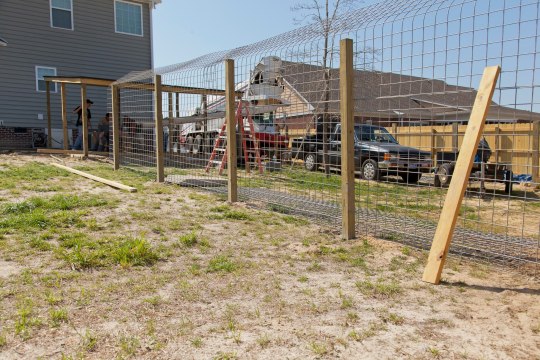
The above containment features panels stacked horizontally to produce 16′X8′ sections. The top two feet of the panels have been bent inward to create lean-ins, which deter climbing. Not all wolfdogs are climbers, but many are, and it’s often considered a good precautionary option.
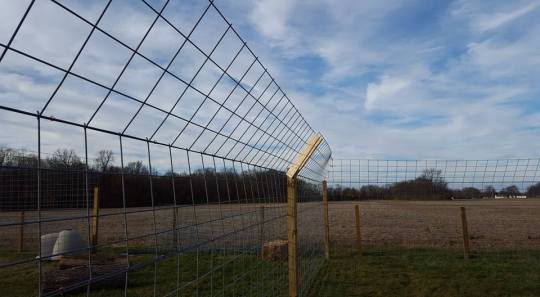
Dig guards at the bottoms of the fencing likewise prevents escapes, and is especially important for intelligent diggers who try to burrow out from underneath. Below is a foiled attempt made by an adamant digger. These guards prevented him from tunneling out of the containment:
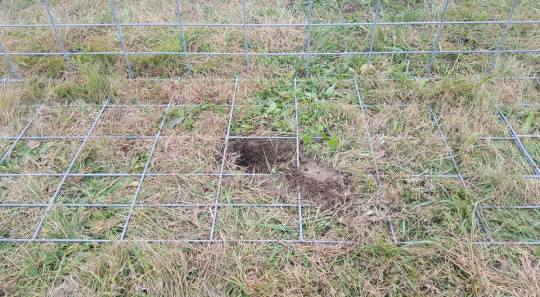
Another type of common and inexpensive fencing material utilized by responsible wolfdogs owners is exotic game field fencing, measuring about 8′ tall and sold in rolls that are usually 100′+ long. Typically used for keeping deer in or out of farms and ranches, it requires a bit more effort (requiring a fence stretcher for proper installation), but is durable and well-suited for keeping wolfdogs safe and secure since they cannot stick their heads out of the holes (as they often can with cattle panel). Here are some examples of enclosures made with exotic game fencing material:

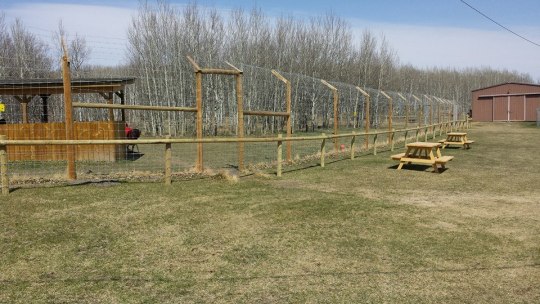
Other types of containment are likewise utilized, from heavy-duty chain link, to welded panels, to a combination of two or more fencing materials, like so:

Aside from lean-ins and dig guards, some wolfdogs may also require double-gated entry systems in their pens to prevent them from slipping past when an owner enters or exists. Double-gated entries are fairly easy to build from the same materials as the fencing, and act as an added barrier in the event that a pup manages to squeeze past a person’s legs.
Below is an example of a double-gated entry system made from cattle panel used in a wolfdog enclosure:
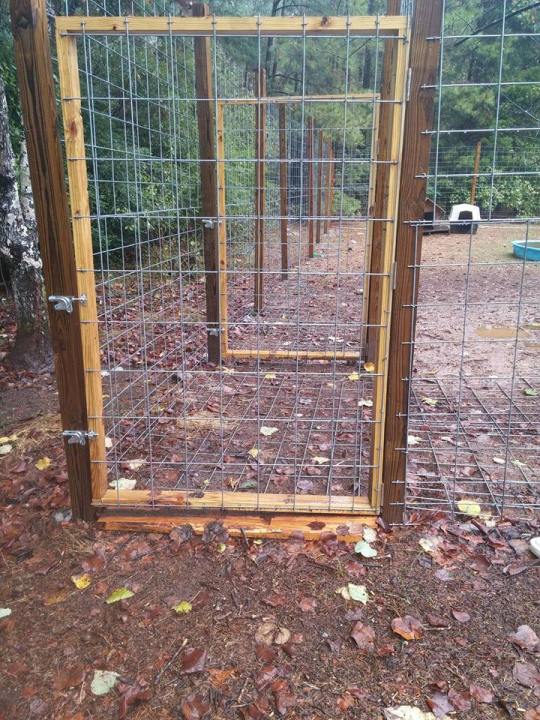
Shelter for wolfdogs is also needed, especially if the pups are permanent or predominantly outdoor residents. Keeping the enclosed sleeping spaces of their shelters small will help them remain warm and dry during inclement weather. Wooden shipping crates, heavy-duty dog igloos, drainage pipe, and custom-built platforms all work well. Just know that wolfdogs are infamous for being good climbers, so will thoroughly utilize any structure in their pen as a lofty perch:


TRAINING:
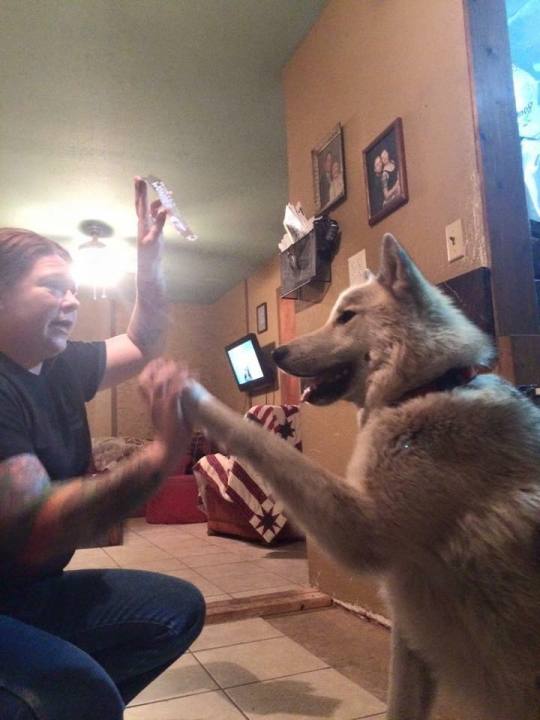
In order to understand wolfdog training, one must first understand both domestic dog behavior, and wolf behavior. This is not as simple as it sounds; many myths and misnomers exist in regards to both.
But one myth rears its ugly head high above the rest: The myth that dogs and wolves need to be dominated or “shown their place” in the pack, and that their human owners need to establish themselves as “alpha”.
In fact, the entire concept of alpha theory in canine social structure is based on misconstrued data collected by an animal behaviorist named Rudolph Schenkel, who, in 1947, published a paper called “Expressions Studies in Wolves”.
Schenkel took several unrelated captive-raised adult wolves, and stuck the confused animals together in an enclosure to examine their behaviors. Not surprisingly, the animals fought - often viciously - for rights to resources in their artificial environment. Schenkel noted that the biggest and toughest animal, who inevitably won the most fights for such resources, seemed to take on the role of what he deemed to be the “alpha” of this rogue pack. From this, he drew the conclusion that all wolves operated on a social hierarchy wherein an alpha earned his place by fighting through the ranks to achieve status, and with that status, easier access to resources, including food, shelter, and breeding rights.
Unfortunately, Schenkel’s study was widely-accepted as fact - even by other researchers. Alpha theory was perpetuated by canine fanciers from all walks of life, and the concepts of “dominance”, “alpha”, and “pack leader” became common notions to the general public, escalated by popular media, TV documentaries, and self-taught “canine behaviorists” across the globe.
Things began to change in 2000, when David L. Mech, a wolf researcher who, unlike Schenkel, studied actual wild wolf packs for his data, determined that the alpha theory was entirely wrong.
In the wild, Mech determined, wolf packs are not just a random mix of unrelated individuals. Quite on the contrary, they are typically composed of a breeding male and a breeding female; the rest of the pack are usually the breeding pair’s offspring.
Unlike the wolves in Schenkel’s experimental captive study, members from a wild pack do not have any need to fight each other for food or breeding rights. The offspring are provided-for by the parent-wolves until the offspring are old enough to mate, at which point, they divert from the pack to seek out other lone wolves from other packs, with whom to start a family of their own.
Scuffles and posturing are common in wolf packs, but these are not the result of animals vying for “rank” or “status” in a hierarchy; they are actually instances of what’s known as situational social dominance - displays of basic communications employed to diffuse or avoid violent conflict between pack members, to establish friendly communications, or to instigate play. They are, as the term suggests, based on the context of the situation at hand. This behavior is willingly displayed and is not exhibited as a forced means of appeasement.

Above, the wolfdog is excited and wants to be petted; by laying down and exposing his belly - a socially submissive posture - he is both encouraging belly-rubs, and showing that he feels safe and comfortable with the human in his presence.
Unfortunately, the damage of Schenkel’s alpha theory study had become so normalized that people, more often than not, still believe it to be fact, and mistakenly apply the notion to their own domestic dogs, using it as an excuse to employ tactics such as jabs, scruffing, alpha rolls, and physical force to teach their animals “right” from “wrong”.
It is even more problematic when applied to wolfdogs, especially those with significant content, as these animals may be less forgiving than domestic breeds, and are often considered “one-time learners”: Highly intelligent problem-solvers, wolfdogs pick up on patterns quickly.
If, for example, an owner jabs their wolfdog to “correct” that animal for growling at a person who makes them uncomfortable, the animal will now associate the human they growled at with the correction they received. That human not only makes them nervous - they are now a negative force in the wolfdog’s life. As a result, the next time that the pup encounters this person, they may surpass the growling behavior, and instead escalate directly to aggression.
Instead of correcting, a responsible owner will first seek to deescalate the situation, by either distancing themselves from the person who made their animal uncomfortable, or by redirecting the wolfdog’s attention with a toy or treat.
It’s important to know that some wolfdogs are naturally more skittish than others, and forcing them into social situations which make them feel uncomfortable is a surefire way to lose that animal’s trust (see below section on socialization). They will not change their lives to suit yours; oftentimes, this meas that you must change your life to suit theirs - even if it means avoiding certain people or places for the comfort of your animal.
Another common mistake made by ill-informed owners is correcting a pup with food aggression. In alpha theory training, the belief is constantly perpetuated that the “alpha” controls the food, so when a pup growls at their owner during feeding time, the owner feels as though the canine is “challenging” their status as alpha.

However, this is not the case. Wolfdogs in particular are driven by instinct, and guarding food is a very common one. Jabbing, scruffing, hitting, or alpha rolling a food-aggressive wolfdog is an excellent way to get yourself bit, and lose your animal’s trust all in one swift moment. Instead, responsible trainers either:
1) Hand-feed their animals, so that they understand that their owner’s close proximity while eating is a positive thing (the source of the food) rather than a negative thing (someone who is going to take the food away or use physical force to get them to stop guarding it). Hand-feeding can be a very long process, but it has worked wonders with many food-aggressive animals.
2) Responsible wolfdog owners may also try a method called “trading up”, wherein they give their pup a command to “leave it” (the food) alone, and, if/when the pup does, they are given a high-value item (such as a favorite toy or special treat) as a reward for the behavior. This instills in the pup the notion that giving up their food is actually a positive thing to do, because it means that they will be given an even greater reward for it.
3) Occasionally, food aggression is so ingrained in a wolfdog’s behavior that training them to cease is not an option. In these instances, it’s best to feed the pup while they are separated from all other people and animals, and simply leave them in peace. Do not make yourself a threat to them while they eat or they may become aggressive even outside of feeding time. Again, this is an example of a situation wherein a wolfdog will not change their life to suit yours, and you will need to change your life accordingly to accommodate isolated feeding sessions.
Clearly, due to the fragile nature of this breed’s temperament, it is imperative that a responsible wolfdog owner understands the concepts of positive-reinforcement training while raising and working with wolfdogs.
With proper guidance, a rare few wolfdog pups can even be trained to perform specialized tasks such a dog-sledding, agility coursing, and scent detection.

SOCIALIZATION:
Early socialization of wolfdog puppies is exceptionally important. These animals are more primitive in nature, and are therefore not as well-adapted to new sights, smells, and stimuli. A wolf in the wild would never encounter a truck or train, nor would it need to become habituated to things such as riding in cars or going to a vet’s office. Yet for wolfdogs, these activities are often important aspects of being a well-adjusted canine citizen.
Starting early and socializing the pup without flooding or overstimulating them is paramount to ensuring that a wolfdog will remain well-adjusted into adulthood.
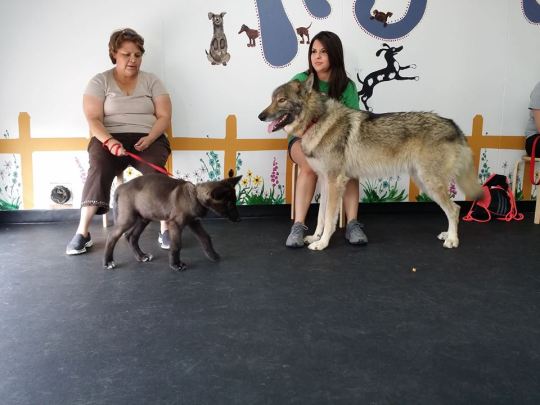
(Above: A young wolfdog puppy and a mature adult wolfdog spend time at a canine training class).
Pups of significant content are often pulled from their parents at a much earlier age than domestic breeds, in order to begin socialization as early-on as possible.
The new pups are introduced to common environmental objects they may encounter, such as sliding doors, lamps, umbrellas, airplanes, and balloons. Wolfdogs seem to be especially skittish around things with moving parts, so getting them used to these objects early on is important when raising a wolfdog from puppy-hood.
Placing a pup in a vehicle, for example, and simply taking off for a drive around the block will likely result in an animal who is overstimulated and afraid to enter a vehicle again in the future. Instead of “flooding” the pup with new things, a responsible owner will to start with small steps using a process called counter-conditioning and desensitization. This process can be applied to all new stimuli.
It starts by first introducing the wolfdog to a new item, such as a vehicle, from a distance. Any time the pup approaches the new object (car) of his own accord, the handler will reward with a treat. This instills in the wolfdog the notion that the car is a good thing; not something scary or threatening.
Once the pup is used to the new sight of the car, usually to the extent of accepting its presence and then completely ignoring it, one may begin coaxing him to enter the vehicle, rewarding for good behavior and praise extensively when the pup decides to step up and into it. A good trainer will ensure the pup is entirely comfortable with the vehicle before beginning a drive.
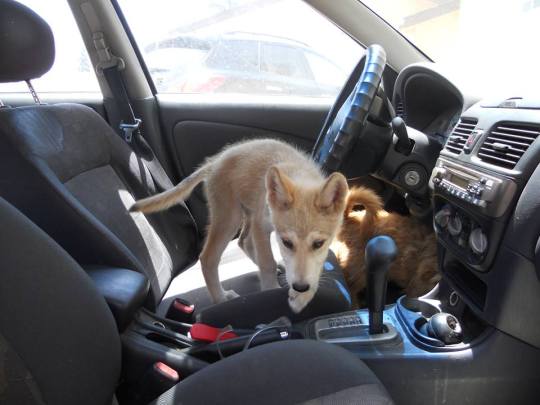
Even then, the first trip will typically be short and sweet. It may take several days or even weeks of practice depending on the pup. Some are better when it comes to socialization than others, and content, as usual, does factor into it.
Rushing the process is liable to do more harm than good, as it instills fear in the animal and a handler will need to start over from square one again.
Using the method of present -> reward -> repeat, a responsible owner can encourage their pups to approach most new and unusual items with confidence. It takes a lot of patience, but is - again - vital to ensuring that a wolfdog becomes well-socialized and steadfast in new situations.
Elizier Morales is the owner of an F3 upper mid-content wolfdog named Yari, who described his experience in socializing his pup as follows:
“There were more than a few times after Yari arrived home that I questioned my abilities and thought to myself, ‘what did I get myself into!?’ She (Yari) would defecate at the mere sight of strangers; she would hide from me and would not want to be touched.
Nevertheless, I continued working with her every day, taking gradual steps, until I made it a point to be calm under any situation, so she could feel that everything was okay. My (non-wolfdog) dogs helped tremendously, as well. Eventually, I started to see the work pay off. By six months, I could walk her in public; a few months later, we could hike in groups. Now, I can do pretty much anything with her and she is one confident wolfdog!”
Below is Yari and her owner at the Griffith Observatory in California:

Socialization is obviously a very tedious but highly important aspect of responsible wolfdog ownership. Higher-content animals, like Yari, demand greater dedication and special care than others.
DIET:
Wolfdogs do best on a specialized meat-based no-filler diet. They are prone to allergic reactions, often manifesting in the form of skin irritations, stomach upset, and loose stools, if fed improperly.
As a result, animals of all content will benefit greatly from a diet that consists mostly of meat, and the Prey Model Raw diet seems to render the best results. It benefits their coats, their teeth, and their digestive tracts, and helps them maintain a healthy weight. Whole carcass feeding is fantastic for this particular breed, and prey species such as chickens, ducks, and rabbits are ideal.

It is a myth that feeding a wolfdog meat will give it a “taste for blood”. Quite on the contrary, animals that are fed with proper portions of raw meat tend to be less likely to express prey drive or food aggression behaviors, because they obtain all their required nutrients from one single meal; this curbs the need to seek out supplementary food between feedings.
It is also a myth that raw bones are detrimental to a canine’s health; the misconception stems from the fact that feeding cooked bones can be dangerous, and is not recommended. However, raw bones do not splinter and do digest fully in the animals’ stomachs. They are a vital part of a raw diet.
When feeding meat from wild animals, or meat that is not previously-frozen, it is best to freeze the meat for a few weeks’ time to kill off any potential parasites or harmful bacteria (this is especially true for fish). Pork, too, should be frozen at -30 degrees for at least two weeks to reduce the risk of trichinosis.
High-quality grain-free kibble can likewise be fed with good results, when occasionally supplemented with meat. Recommended brands of kibble of this nature include Solid Gold, Acana Regionals Grain-Free, and Evo. Recalls should be closely-monitored for all kibble foods.
Additional supplements are beneficial regardless of whether the pup is fed on raw or kibble. Glucosamine (for arthritis and stiffness), vitamin C (for infection and the immune system), fish oil (for skin and coat problems), vitamin A, B, D and E (for various conditions), alfalfa and wheat grass (for internal parasites), pumpkin (for digestion), and garlic (for internal and external parasites, as well as the immune system) are very helpful when needed.
DEALING WITH OTHER PEOPLE AND YOUR WOLFDOG:
Not everyone likes wolves or wolfdogs. They view these animals as inherently vicious or apt to attack without warning. Even though that is clearly not the case, it’s still important for a good owner to keep a positive public face and respect others who may not wish to interact with their animals.
It is an owner’s responsibility to keep their wolfdog under control, and to be on high alert at all times. Wolfdogs in particular are not given “second chances” due to their wild nature. They are also not protected by rabies vaccinations like domestic dogs are, even though the vaccine has been proven to work on them. This means that if a wolfdog bites, licks, or slobbers on a person who does not like it, the pup may be reported to and seized by authorities before being put down.
It is not unheard-of for wolfdog owners’ animals to become the targets of malicious attacks and slanderous claims from those who do not approve of them being kept in private ownership, or who otherwise hold vendettas against the breed.
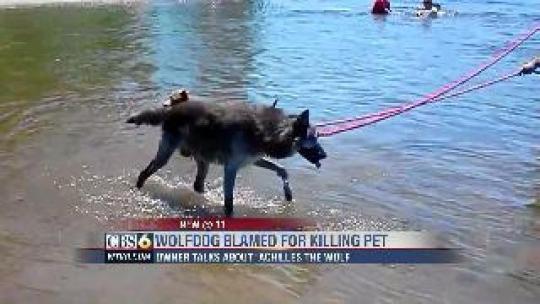
For these reasons, it’s important for wolfdog owners to be respectful of other people who may feel uncomfortable around wolfdogs; They must remain calm and collected in the event of trouble, and won’t hesitate to contact local law enforcement if they feel as though someone may be threatening them or their animals. In the event of trouble, it’s recommended that an individual keep a record of all pertinent incidents, down to exact date and time of their occurrence, in case the situation escalates.
Some responsible wolfdog owners will utilize closed-circuit security systems in their animals’ enclosures to ensure no one antagonizes their pups.
Owners meet a lot of folks who are also very interested in and excited to pet or play with their wolfdogs.

Wolfdogs are uncommon and often incredibly beautiful animals, after all, and many do indeed enjoy interactions with friendly strangers. But this is not the case with all of them, so it’s important for responsible owners to politely but sternly express if and when their animals are uncomfortable with any interaction.
Some partake in premeditated measures, especially when training a skittish animal, and employ the use of “DO NOT PET” vets, like so, to keep curious folks at bay from a greater distance:

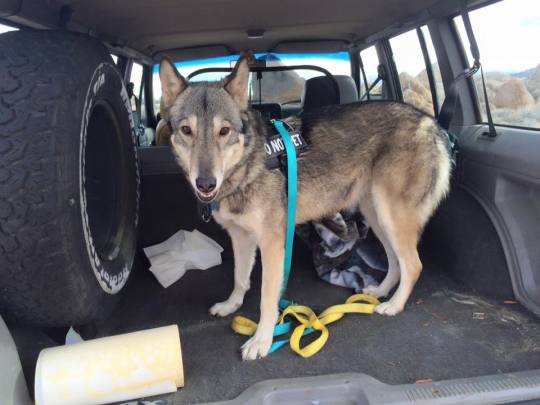
MISREPRESENTATION:
One of the biggest issues wolfdogs face is misrepresentation. People with non-wolfdogs often make false or improper claims of wolf content in their animals, which in turn, gives others the wrong impression about how real wolfdogs look and act.
People may look at a husky/shepherd mix who’s claimed as “part wolf” and think, “I want a wolfdog just like that one!” They then do one of two things:
1) They go out and get another wolfy-looking domestic breed and continue the cycle of misrepresentation by telling other people that it’s “part wolf”, spreading more harmful confusion and myths about the breed.
2) Or, they go out and get an actual wolfdog, expecting it to act just like their friend’s husky/shepherd mix. When the wolfdog, true to form, acts like a legitimate primitive-breed canine, they find that they are unprepared to provide it with proper care, and the pup ends up in a rescue situation.

The cycle of misrepresentation also affects non-wolfdogs: In the fall of 2015, a husky named Karma was confiscated from her owners after a neighbor claimed that Karma was vicious, and had killed two neighborhood cats. While in holding pending a court hearing about the incident, the claim was made that Karma was a wolfdog, which launched a full investigation, including DNA tests and temperament evaluations of the unfortunate husky.
According to the court, the DNA tests came back “positive for recently wolf ancestry”. In truth, a series of genetic markers in Karma’s DNA were matched against known wolf DNA sequences. Of 80-something markers being examined, Karma shared only 15 similarities. Most domestic dogs show an average of 8. And so, since Karma had 6 more markers than a garden variety golden retriever, she was labeled as a “wolf hybrid” and was thus deemed a “dangerous exotic animal”.
False positives like this are common in DNA tests, and are part of the reason that Pack West relies heavily on a process called phenotyping to determine wolf content, as opposed to DNA testing.
Karma the husky was spared from euthanasia following a large-scale rescue operation (which involved the collection of more than 335,000 signatures on a petition to spare her life). She was transported to fellow rescuers at Full Moon Farms wolfdog sanctuary, where a phenotype proved that Karma had no indication of recent wolf ancestry whatsoever.
She was still nearly killed due to false claims of content. Not all pups are as lucky as Karma.
Wolfdogs submitted to county shelters are not available for adoption to the general public, and, as a result, are often put to sleep. A male husky/malamute mix taken in as a stray was erroneously labeled as a “wolf hybrid” by uneducated staff, and was euthanized before anyone in the rescue community had the opportunity to save him.

Pack West dedicates most of our educational outreach to ending this dangerous cycle, in an effort to cut back on the number of animals needing rescue to begin with. We plan to offer courses on basic wolfdog identification to shelters, animal control officers, and veterinary staff to help stop misrepresentation in its tracks.
Responsible wolfdog owners understand these dangers and are honest about the content of their animals. If they don’t know their pups’ content, they are sure to say so. If a supposed wolfdog does not show signs of having actual wolf content, a responsible owner doesn’t call that animal a wolfdog at all.
FINAL NOTES:
Wolfdogs are difficult companion animals for most members of the general public due to their high-maintenance care. Pack West offers presentations and educational seminars at various locations throughout the Pacific Northwest for those who are interested in learning more and working hands-on with this unique breed.
If you live outside the Pacific Northwest or cannot otherwise attend such seminars, and feel that you have a wolfdog which exceeds your care-giving capabilities, please consider reading the following resources. Remember: These are animals that will not change their lives to suit yours - you will have to change your life to suit theirs. This means making some big (and often, permanent) changes. It is better to make these changes and become a better owner for your wolfdog than it is to send the pup to a rescue/sanctuary, when possible:
Quality of Life of Wolfdogs.
Containment Solutions for Wolfdog Owners.
Avoiding Dominance Training while Training Wolfdogs.
Advice for Jumping/Digging/Chewing Behavior Problems.
Additional Notes in Socializing a Wolfdog Puppy.
3K notes
·
View notes
Photo

deathless benevolence is killing me and
my heart hurts for you love the facade of it
115 notes
·
View notes
Photo

My first litter is a week old today! They’re growing crazy fast and all 7 seem to be thriving. Eeeeeee!!
157 notes
·
View notes
Photo

a sturdy, elegant perennial plant from my garden to yours
122 notes
·
View notes
Note
Gayest dinosaur to ever live: Go.

The gayest dinosaur to ever live is the black swan (Cygnus altratus). An estimated 25% of male black swans are homosexual or bisexual, forming pair bonds with other males and stealing the eggs of females to raise as their own. This is the highest rate of homosexuality among any known dinosaur species; the mallard duck (Anas platyrhynchos) has a rate almost as high, with 19% of all males forming homosexual pair bonds. (Unlike black swans, homosexual mallard ducks seem to be uninterested in raising young.)

The most famous gay dinosaurs are penguins (family Spheniscidae). Numerous penguins in captivity have formed same-sex pair bonds, and have successfully hatched foster eggs and raised surrogate offspring. Homosexual behavior among penguins has also been reported in the wild.

Homosexuality is very common in the animal kingdom - perhaps even more than we currently realize, thanks to the various stigmas that discourage its study. Petter Bøckman, a scientist at the Natural History Museum at the University of Oslo, has said: “No species has been found in which homosexual behavior has not been shown to exist, with the exception of species that never have sex at all.” As a result, it seems likely that most, if not all, dinosaur species engaged in homosexual activity of some variety or another.
(All images from Wikimedia Commons)
18K notes
·
View notes







